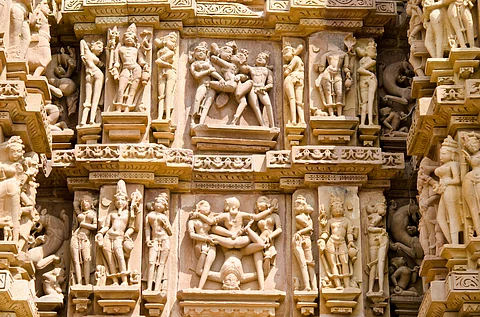
- Destinations
- Experiences
- Stay
- What's new
- Celebrating People
- Responsible Tourism
- CampaignsCampaigns
- SubscribeSubscribe
- Buy Now

Pride Month 2025 | The polytheistic religion of Hinduism has a long tradition of gender fluidity and queer identity as reflected in its deities and scriptures. From the numerous stories of Krishna, Shiva and Vishnu shape-shifting into feminine forms to the carvings of Khajuraho and Konark, which depict sexual relationships between gender-diverse and same-sex individuals, Indian tradition’s embrace of varying sexualities stands in stark contrast to the prevailing sentiment of LGBTQIA+ rights in the country.
In honour of Pride Month 2025 in India, here’s a look at how queer relationships and sexualities are depicted in the mythological stories and built spaces of Hindu temples.
Ardhanarishvara is the combined form of the Hindu deities Parvati and Shiva. Signifying the merging of the masculine and feminine energies of the universe, the deity is depicted as half-male and half-female, equally split down the middle.
The earliest Ardhanarishvara images date to the Kushan period, starting from the first century CE. The “Puranas” and various iconographic treatises write about the mythology and iconography of Ardhanarishvara, which remains a popular iconographic form found in most Shiva temples throughout the country.
Mohini is the Hindu deity of enchantment and the only female avatar of Vishnu. She is portrayed as a femme fatale who maddens lovers and demons, sometimes leading them to their doom. Mohini is first introduced in the narrative epic of the “Mahabharata,” where she distributes amrita (the elixir of immortality) to the weakened devas (gods) in their battle against asuras (demons).
Many different legends tell of her various exploits and marriages, including her union with Shiva. Mohini is mainly worshipped in western India, where temples are devoted to her as Mahalasa, the consort of Khandoba, a regional avatar of Shiva.
Shikhandi is a character in the “Mahabharata” who was born as the daughter of Drupada, the King of Panchala, but becomes male after agreeing to a sex exchange with a yaksha (nature spirit). In fact, they are a reincarnation of Amba, a princess who was abducted by Bhishma and later spurned by him. Heartbroken and ashamed, Amba sought revenge against Bhishma, so the gods promised to make her a man in her next birth.
Shikhandi plays a prominent role in the Kurukshetra war between the Kauravas and Pandavas. During the ninth day, he travels with Arjuna in his chariot to defeat Bhishma, who has vowed never to strike a woman. Knowing Shikhandi was Amba in a previous life, Bhishma lays down his arms and is defeated.
In the Javanese wayang tradition, Shikhandi is known as Srikandhi and is born as a male before changing into a woman. She becomes the second wife of the Pandava brother Arjuna.
This 13th-century temple in Odisha reflects the pinnacle of Kalingan architecture and artistic excellence. The structures and elements that have survived are famed for their intricate artwork, iconography and erotic scenes.
The latter depicts same-sex couples, heterosexual couples and human-animal hybrids in various stages of courtship and intimacy. This uninhibited celebration of sexuality that cuts across human life and powerful deities, taking inspiration from the ancient Indian Hindu text of the “Kama Sutra.”
The Khajuraho temples feature a variety of artwork, of which an estimated 10 per cent is sexual or erotic art that features individuals engaging in intercourse with human-animal hybrids and those of the same-sex. There are depictions of threesomes, orgies and bestiality.
The village of Koovagam in Tamil Nadu is well-known for its annual festival that brings the transgender community together. Taking place over 15 days in April or May, the celebrations centre around the Koothandavar Temple, which dedicated to Iravan, the patron god of the Alis transgender community.
During the festival, the participants marry Iravan in a reenactment of the mythological marriage between him and Mohini. The next day, the participants mourn his death through ritualistic dances and by breaking their bangles. The festival also includes a beauty pageant, other competitions and discussions of transgender rights.
